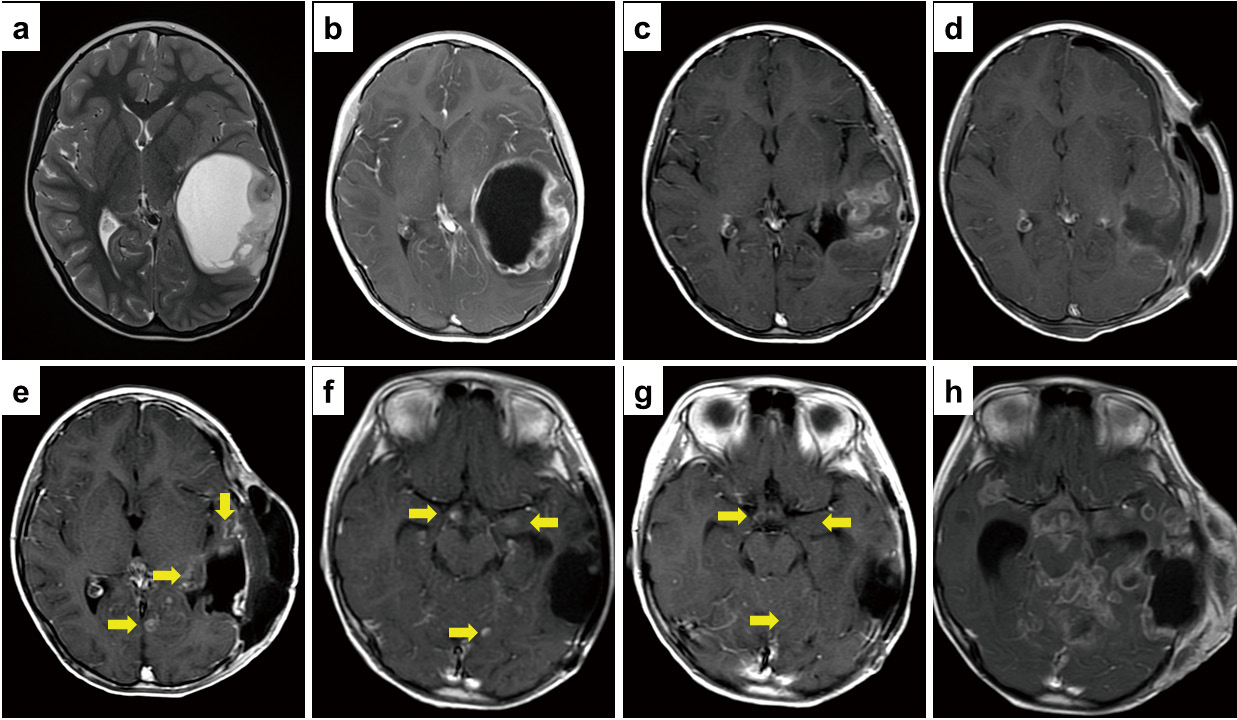- 著者
- Kentaro CHIBA Yasuo AIHARA Yuichi ODA Kenta MASUI Takashi KOMORI Hideaki YOKOO Takakazu KAWAMATA
- 出版者
- The Japan Neurosurgical Society
- 雑誌
- NMC Case Report Journal (ISSN:21884226)
- 巻号頁・発行日
- vol.10, pp.265-271, 2023-12-31 (Released:2023-10-14)
- 参考文献数
- 32
Extracranial brain tumor metastases are extremely rare. The etiology, pathophysiology, and clinical progression of systemic metastatic brain cancer remain to be elucidated. We encountered a case of pediatric diffuse high-grade astrocytoma in a four-year-old girl with subcutaneous and lymph node metastases. Numerous metastatic lesions emerged, progressed rapidly, and were difficult to manage despite temozolomide (TMZ) administration. The patient underwent repeated surgical resection for these lesions. Conversely, the primary intracranial lesions responded well to TMZ for some time. However, the patient died 15 months after the initial diagnosis. Extracranial metastasis and highly varying effects of chemotherapy were the characteristic clinical features in this case. Our analysis did not reveal definitive histopathological and molecular factors contributing to this presentation. The lack of notable molecular pathological features illustrates the unpredictability of glioma metastasis, and the treatment for extracranial metastasis remains unknown. A gene panel analysis revealed several genetic aberrations, including PDGFRA, PIK3CA, and NBN mutations. As it is impossible to resect all frequently and rapidly progressing lesions, we stress that the prognosis of metastatic brain tumors is undoubtedly poor if these tumors are refractory to existing treatments, including chemotherapy.
1 0 0 0 OA Pediatric Optic Pathway/Hypothalamic Glioma
- 著者
- Yasuo AIHARA Kentaro CHIBA Seiichiro EGUCHI Kosaku AMANO Takakazu KAWAMATA
- 出版者
- The Japan Neurosurgical Society
- 雑誌
- Neurologia medico-chirurgica (ISSN:04708105)
- 巻号頁・発行日
- vol.58, no.1, pp.1-9, 2018 (Released:2018-01-15)
- 参考文献数
- 42
- 被引用文献数
- 44
Optic pathway/hypothalamic gliomas (OP/HGs) are rare astrocytic tumors that appear more commonly among young children and often are unresectable. They comprise approximately 2% of all central nervous system tumors and account for 3–5% of pediatric intracranial tumors. Initial manifestations are often visual disturbances, endocrinopathies and hypothalamic dysfunction such as the diencephalic syndrome, and sometimes hydrocephalus due to cerebrospinal fluid (CSF) outflow obstruction. In many cases, the tumors are diagnosed late in the clinical course because they silently enlarge. These tumors consist mostly of histologically benign, World Health Organization (WHO) grade I tumors represented by pilocytic astrocytomas (PA), the rest being pilomyxoid astrocytomas (PXA) – WHO grade II tumors. In young pediatric patients, however, can be seen PXA that show aggressive clinical course such as CSF dissemination. Our small series of 14 non-Neurofibromatosis type 1 (NF-1) OP/HGs PA patients underwent extended resection without any adjuvant treatments. The median age at initial treatment was 11.5 ± 6.90 years (range, 1–25 years) and median follow up 85.5 ± 25.0 months. Surgical resection for OP/HGs results in acceptable middle-term survival, tumor control and functional outcome equivalent to chemotherapy. There is, however, no longer doubt that chemotherapy with or without biopsy and as-needed debulking surgery remains the golden standard in management of OP/H. Clinical conditions and treatment plans for OP/HGs vary depending on their structure of origin.
